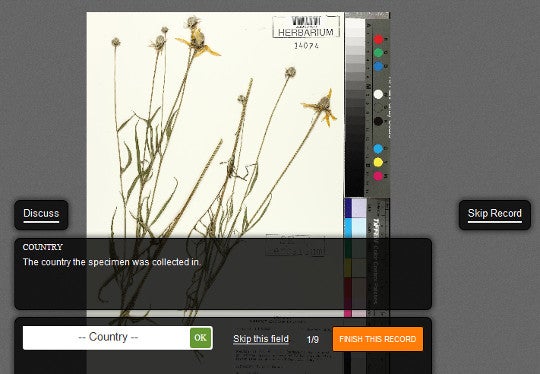This article was published in Scientific American’s former blog network and reflects the views of the author, not necessarily those of Scientific American

Screenshot from notesfromnature.org
It’s been a while since I featured a citizen science project here at The Artful Amoeba, but I learned of one last week that I think may be of interest to you. It’s called Notes from Nature, and the aim is simply to digitize some of the millions of herbarium and natural history specimen labels squirreled away in smelly cabinets and drawers across the country. This information tells us much about biodiversity, evolution, and climate change, but to be most useful, it needs to live in a form that can be searched by scientists anywhere, not just ones with fat travel budgets.
Your job, essentially, is transcriptionist, but your secondary role is voyeur. You get to have a peek at specimens you otherwise would never get to see. You get a glimpse into a past place and time where a person found a mushroom or plant that was of enough interest to them they plucked it from the ground, hauled it back to a university, and took the time to write about what they found.
On supporting science journalism
If you're enjoying this article, consider supporting our award-winning journalism by subscribing. By purchasing a subscription you are helping to ensure the future of impactful stories about the discoveries and ideas shaping our world today.
I tried out the format myself. Good: No need to register to help! You can simply start transcribing after reading a short intro. Bad: There is often no way to go back and fix typos, mistakes or omissions on the current platform if you accidentally click “OK” on a field before you are ready. They will be moving to a new platform this summer, however, so let’s hope they fix that issue.
It helps if you have a talent for deciphering handwriting, as many of the labels are in longhand and require a bit of puzzling out.

Screenshot from notesfromnature.org
It also helps to be willing to do a little detective work. You may need to discover whether a particular phrase is a common plant name, a habitat, or something related to the location. Counties are always required, but counties are not always given on the forms. And counties are not always even used – or have changed since the specimen was collected, as I discovered when trying to transcribe a specimen from remote British Columbia collected in the 1960s, where electoral districts are used and have changed since then. And at least one plant specimen I looked at appeared to have at least two or three different collectors’ names on it. It’s your job to figure out who was the original.
As with most citizen science projects, it is a fun way to take a break for a few minutes, blow off some steam, or just get in some good old-fashioned procrastinating time while still doing something constructive for science. Or perhaps you broke a leg and six ribs in a ski accident and are bedbound for three months. Here’s a great way to spend your time, assuming, of course, you still have the use of your hands.
The team, as I mentioned, is trying to move to a new platform and website this summer. Before they do, they are trying to get their last fungus and plant collections finished by the end of May – and judging from the website they still have more than 15,000 transcriptions to go. The remaining two are plants from the Southeastern Louisiana University Herbarium and fungi from the Macrofungi Collection Consortium. If you have a few spare moments to donate and are botanically curious, like reading old handwriting, and willing to solve a few small puzzles, check it out!